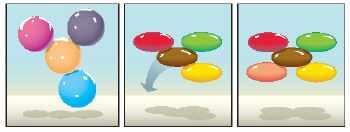Using M&Ms a group of physicists in the US have discovered that oval-shaped objects can pack together more densely than spherical-shaped ones – contrary to what was previously believed. Paul Chaikin and colleagues at Princeton and Cornell universities believe their results could have implications for applications as diverse as designing high-density ceramics and reducing the cost of transporting goods (A Donev et al. 2004 Science 303 990)

Mathematicians and physicists have long been interested in how objects pack together. In the sixteenth century, Johannes Kepler predicted that the densest possible arrangement of spheres would fill about 74% of the total available space. However, it was not until 1998 that this arrangement was mathematically proven to be an ordered face-centred cubic lattice. Random or amorphous packing fractions are lower, and fill a maximum of only 64% of the total available space.
Now, Chaikin and colleagues have shown that spheroids – like M&Ms – can randomly pack more densely to fill between 68 to 71% of the total available space. Moreover, they found that cigar-shaped ellipsoids could be randomly packed with a density of almost 74%.
The Princeton-Cornell team determined the packing fractions of M&Ms in different shaped containers and then compared these results to those obtained with spherical ball bearings measuring about 3 millimetres across. The team used magnetic resonance imaging (MRI) to confirm that the sweets had not arranged themselves in an ordered “crystalline” structure.
Chaikin and colleagues believe that the higher packing densities are possible because spheroid and ellipsoid particles are free to move in the container. Spherical particles can only rotate but non-spherical particles can also move sideways to settle into more stable positions. Furthermore, the team found that this movement was related to the number of contacts created between neighbouring particles. This number is higher for spheroids than spheres.




